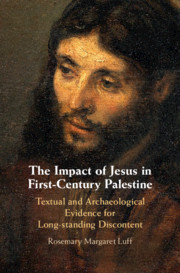 The Impact of Jesus in First-Century Palestine
The Impact of Jesus in First-Century Palestine from Part II - Jesus in Context: The Archaeological Evidence
Published online by Cambridge University Press: 26 July 2019
Using archaeological and textual evidence, this chapter discusses the nature and prevalence of infectious disease in early Palestine. An analysis of the human bones from Palestinian tombs, in particular the ones relating to the urban sites of Jerusalem and Jericho, demonstrates a high level of subadult deaths especially of infants. Those socially and economically advantaged were equally at risk with those less well off when faced with an aggressive and persistent pathogen, as evidenced by the Akeldama tombs containing the remains of the wealthy. In one tomb, poor maternal health is suggested by the long-bone measurements of new-born infants, which are well below the norm for the period. And in another tomb (Tomb of the Shroud) both leprosy and tuberculosis were identified in a high-class man, possible a priest. Yet another Akeldama tomb revealed the remains of a man severely infected by the hydated tapeworm Echinococcus granulosus. Malaria is described by Josephus with reference to a Hasmonean king in the first century BCE, but there is no evidence that it was a serious problem in the first century, and certainly there is no evidence for the deadly falciparum form.
To save this book to your Kindle, first ensure [email protected] is added to your Approved Personal Document E-mail List under your Personal Document Settings on the Manage Your Content and Devices page of your Amazon account. Then enter the ‘name’ part of your Kindle email address below. Find out more about saving to your Kindle.
Note you can select to save to either the @free.kindle.com or @kindle.com variations. ‘@free.kindle.com’ emails are free but can only be saved to your device when it is connected to wi-fi. ‘@kindle.com’ emails can be delivered even when you are not connected to wi-fi, but note that service fees apply.
Find out more about the Kindle Personal Document Service.
To save content items to your account, please confirm that you agree to abide by our usage policies. If this is the first time you use this feature, you will be asked to authorise Cambridge Core to connect with your account. Find out more about saving content to Dropbox.
To save content items to your account, please confirm that you agree to abide by our usage policies. If this is the first time you use this feature, you will be asked to authorise Cambridge Core to connect with your account. Find out more about saving content to Google Drive.